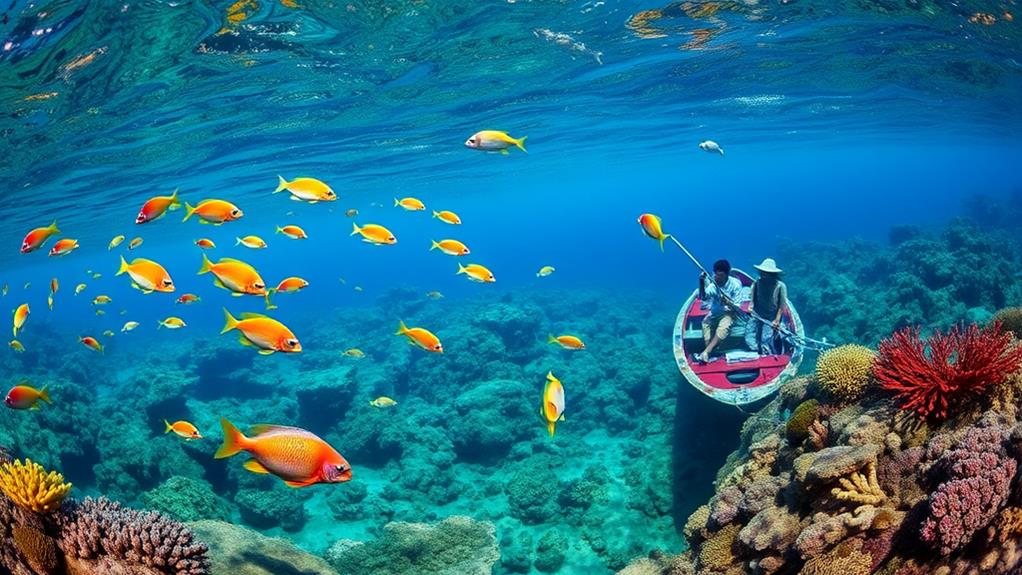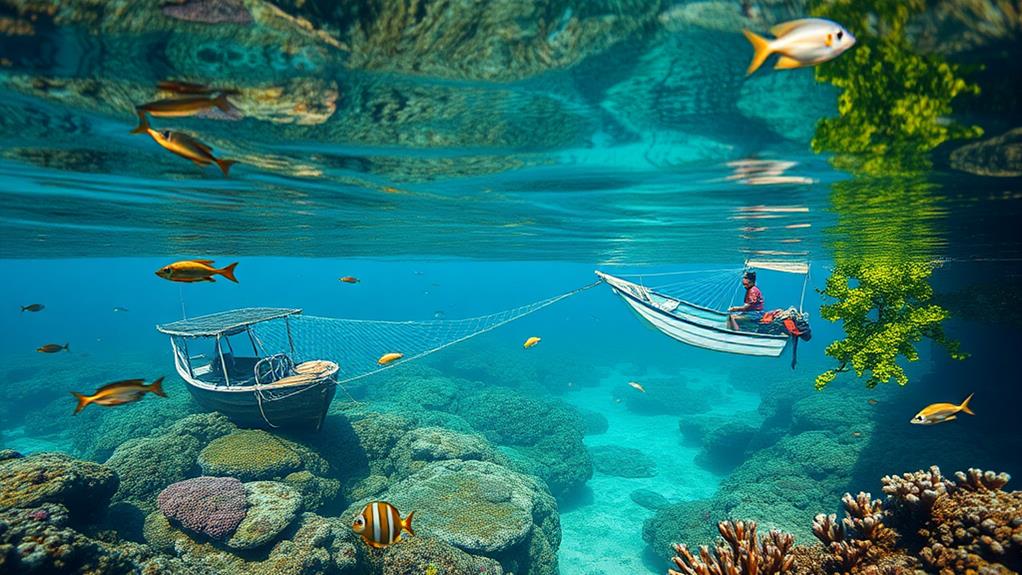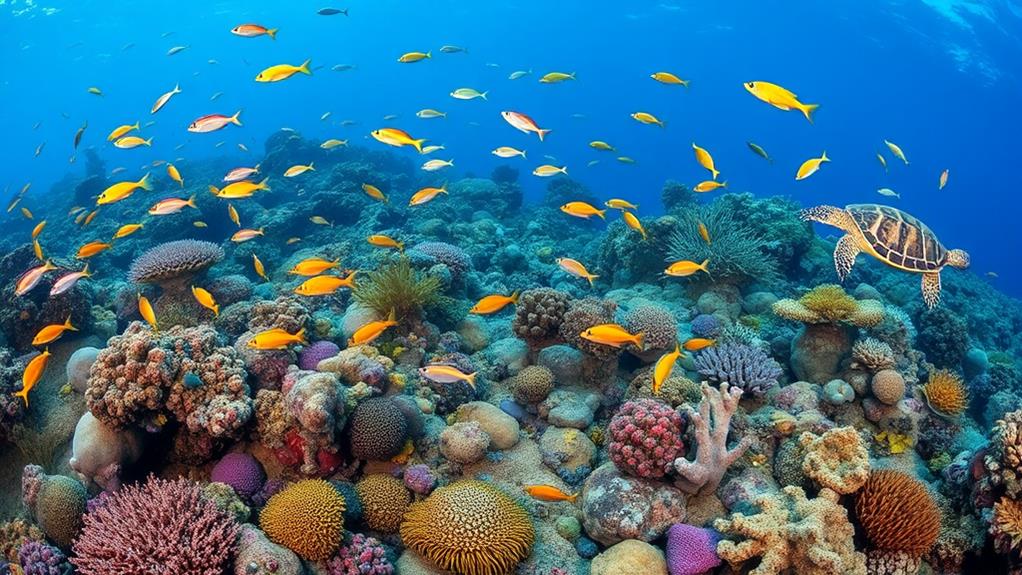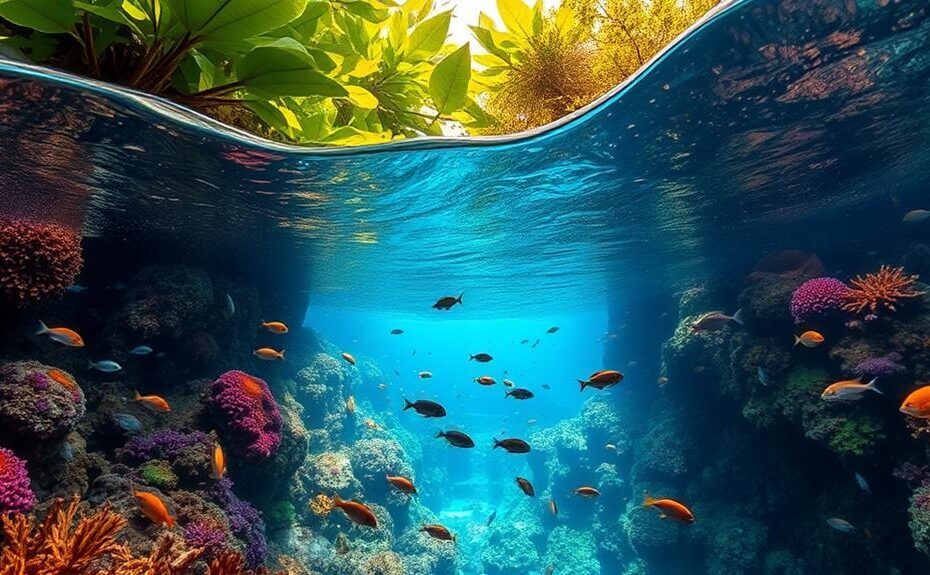The Verde Island Passage is a critical hub for marine shorefish biodiversity. This passage is home to over 1,700 species, including threatened ones, and spans more than 1.4 million hectares.
It connects the West Philippine Sea and Tayabas Bay, featuring 54 marine protected areas. The unique evolutionary history of this area enhances its rich biodiversity, which is vital for maintaining healthy marine ecosystems and local economies.
However, this delicate balance is threatened by challenges like overfishing and pollution.
To address these issues, effective conservation measures and community involvement are essential for protecting the passage's resources.
Geographic Overview and Importance

The Verde Island Passage is a vital marine corridor located between Luzon and Mindoro in the Philippines. This passage connects the West Philippine Sea and Tayabas Bay, creating a dynamic ecosystem that supports an impressive range of biodiversity.
The passage is home to over 1,700 marine species, including critically endangered species like hawksbill turtles and giant groupers. This biodiversity earns it the title of Center of Marine Shorefish Biodiversity.
The Verde Island Passage spans more than 1.4 million hectares and includes 54 marine protected areas (MPAs). These MPAs play a crucial role in conservation efforts by maintaining ecological balance, safeguarding habitats, and enhancing sustainable fisheries.
The passage's historical significance as a major sea lane for trade and travel further underscores its importance, attracting divers and researchers eager to explore its rich marine life.
The exceptional biodiversity of the passage has earned it the nickname "Amazon of the oceans". This designation highlights the ecological importance and urgent need for continued conservation efforts to protect the unique species and habitats within the Verde Island Passage.
Marine Biodiversity Highlights
The Verde Island Passage is a hub of marine biodiversity, boasting an extraordinary array of species that underscores its ecological significance. This region is home to over 1,700 marine species, including a diverse range of fish and coral.
The area is a critical habitat for endangered species, such as hawksbill turtles, whale sharks, and giant groupers, highlighting its vital role in conservation efforts. In 2015, the California Academy of Sciences reported the discovery of 100 new species within the Verde Island Passage, emphasizing the ongoing biological significance of the region.
The unique evolutionary history and geographical positioning of the Verde Island Passage contribute to its remarkable biodiversity. This biodiversity is crucial for sustaining local fisheries and maintaining ecological balance.
Protecting this marine biodiversity ensures the health of marine ecosystems and supports the livelihoods dependent on them.
Economic Contributions

The Verde Island Passage's Economic Significance
The Verde Island Passage is a significant contributor to the regional economy, with its vibrant fishing industry generating approximately P1 billion annually. This revenue is crucial for local communities that rely on marine resources for their livelihood.
Fishing Industry and Coastal Tourism
The fishing industry is a major economic driver, providing a livelihood for local communities.
Additionally, coastal tourism thrives in the area, driven by the rich marine biodiversity, attracting visitors for diving and other marine-related activities. This tourism sector contributes P500 million to the local economy, supporting employment and local business growth.
Shipping and Trade
The Verde Island Passage also serves as a busy shipping corridor, facilitating international commerce and generating P300 million in revenue.
Sustainable Practices and Resource Management
Sustainable fishing practices are essential to protect marine resources while supporting the livelihoods of over 2 million people dependent on these ecosystems.
As economic activities increase, the need for balanced resource management becomes crucial to safeguard both the economy and marine biodiversity.
With proper strategies, the Verde Island Passage can maintain its economic vitality while preserving its remarkable marine resources.
Conservation Challenges
Human activities in the Verde Island Passage pose significant conservation challenges. Overfishing and illegal fishing practices threaten the delicate balance of marine life, particularly impacting species already classified as threatened. For instance, the passage holds the highest concentration of marine shorefish biodiversity, making its preservation critical for ecological stability.
Environmental degradation worsens the situation. Pollution from urban runoff and agricultural practices exacerbates the challenges. Commercial vessels contribute to the problem by discharging pollutants, which deteriorates water quality and harms marine habitats.
The recent oil spill from the MT Princess Empress highlights the ecosystem's fragility and raises concerns about regulatory enforcement measures.
Infrastructure limitations hinder conservation efforts. The lack of sufficient infrastructure for oil or chemical spill containment near Batangas Bay complicates efforts to protect these fragile ecosystems.
Declaring the Verde Island Passage as a protected area is essential. This will enable the implementation of effective management mechanisms, crucial to marine conservation efforts. These efforts will ensure the preservation of the passage's unique biodiversity while addressing ongoing environmental threats.
Sustainable Practices

Preserving Marine Biodiversity
In the Verde Island Passage, sustainable practices are crucial for preserving marine biodiversity while supporting local communities. Conservation International focuses on improved fishing practices to address fish stock depletion, ensuring sustainable livelihoods. This involves community training sessions that emphasize sustainable fishing methods, seasonal closures, and the establishment of marine protected areas, enhancing marine resource management.
Sustainable Practices and Their Impact
| Sustainable Practices | Impact on Communities |
|---|---|
| Improved fishing practices | Enables sustainable livelihoods |
| Community training on marine resources | Increases awareness and skills |
| Rehabilitation of mangroves | Secures ecological benefits and habitat |
Marine Protected Areas
The establishment of marine protected areas has led to a 17-fold increase in protected habitats, covering over 16,000 hectares. This expansion secures food sources and livelihoods for local populations. Furthermore, over 60 individuals in pilot communities have undergone income diversification training, fostering resilience and reducing reliance on dwindling marine resources.
Prioritizing Sustainable Practices
Community Involvement
Community Involvement is Crucial for Conservation
Community involvement is essential for the success of conservation strategies in the Verde Island Passage.
Local residents are actively managing and monitoring marine protected areas, which is vital for preserving marine diversity. For instance, over 60 individuals in pilot communities have received training in income diversification, promoting sustainable livelihoods that align with conservation initiatives.
Community Members Take Ownership of Conservation Efforts
Community members are actively participating in mangrove conservation and patrolling efforts, fostering a sense of stewardship and accountability for their marine resources.
Collaborative projects between Conservation International and local communities have facilitated knowledge sharing on sustainable fishing practices, reducing environmental pressures on the region's ecosystems.
Effective Conservation Requires Community Engagement
Ongoing discussions emphasize the importance of community engagement in improving conservation efforts.
By including local voices in decision-making processes related to marine resource management, Local Government Units can foster more effective and inclusive conservation strategies. This integrated approach strengthens community ties and enhances the overall resilience of marine ecosystems in the Verde Island Passage.
Future Conservation Directions

Future Conservation Directions
To effectively conserve the Verde Island Passage, a multi-faceted approach is necessary. Declaring the region a protected area is a critical step, providing a framework for safeguarding marine species and their habitats.
Research is vital to understanding marine biodiversity patterns and climate change impacts, informing effective conservation strategies. This knowledge will help identify areas that require immediate attention and guide efforts to mitigate the effects of climate change.
Strengthening partnerships among local communities, government entities, and NGOs is essential to implement sustainable practices. For example, engaging local stakeholders fosters community stewardship in conservation initiatives, making them active participants in preserving their marine environment.
Expanding educational programs will raise awareness about marine biodiversity's significance and the necessity of conservation, ensuring local engagement and support for sustainable tourism models.
Stricter enforcement of existing fishing regulations and environmental protections is necessary to combat threats posed by overfishing, pollution, and habitat degradation. This will help maintain the delicate balance of the marine ecosystem and preserve its rich biodiversity.
Environmental Threats and Solutions
The Verde Island Passage faces significant environmental threats that put its marine biodiversity at risk. Overfishing and illegal fishing practices deplete fish populations, disrupting the balance of marine ecosystems. For example, the passage's fish populations have decreased drastically due to unregulated fishing. Pollution from urban and agricultural runoff further exacerbates these challenges, while commercial vessels inflict physical damage to habitats.
The MT Princess Empress oil spill disaster is a recent example of the acute risk to marine life, with potential impacts reaching key areas like Calapan and Verde Island.
Inadequate regulatory enforcement hinders conservation efforts. Insufficient infrastructure for spill containment and ineffective implementation of fishing ordinances are major obstacles.
For instance, the lack of resources for responding to oil spills puts marine life at greater risk. To address these environmental threats, community involvement in conservation initiatives is crucial. Engaging local stakeholders fosters stewardship and promotes sustainable fishing practices, which are essential for mitigating overfishing's impacts.
Local fishermen, for example, can help monitor fishing activities and report illegal practices.
Stronger protective measures are urgently needed. Proposals to declare the Verde Island Passage as a protected area can provide the necessary framework for safeguarding its unique marine biodiversity.
By implementing effective regulations and enhancing community participation, the passage can thrive for future generations.
Questions and Answers
What Marine Species Are in the Verde Island Passage?
The Verde Island Passage is home to over 1,700 marine species. This remarkable biodiversity is a testament to the area's ecological significance.
Many of these species are found only in this region, making conservation efforts crucial to protect them.
Endangered species like hawksbill turtles and whale sharks are a priority. These gentle giants are an integral part of the marine ecosystem.
Diverse fish populations also thrive in the passage, with many species relying on the area's unique habitats.
Understanding and preserving this biodiversity is vital to maintain the delicate balance of the ecosystem.
Sustainable management of these habitats ensures their long-term survival, which is essential for the health of the entire ecosystem.
What Is the Center of the Center of Marine Shore Fish Biodiversity?
The center of the center of marine shorefish biodiversity is the Coral Triangle, a region in the western Pacific Ocean that spans across six countries: Indonesia, Malaysia, the Philippines, Papua New Guinea, the Solomon Islands, and Timor-Leste.
This area is characterized by exceptional ecosystem dynamics, where species interactions play a crucial role in maintaining ecological significance.
The Coral Triangle is home to over 2,000 species of fish, more than 600 species of coral, and many other creatures like sharks, rays, and turtles.
This biodiversity hotspot is essential for the survival of many marine species and supports the livelihoods of millions of people who depend on fishing and tourism.
Understanding the center of marine shorefish biodiversity is critical for developing effective conservation strategies.
What Is the Center for Marine Biodiversity?
The Center for Marine Biodiversity refers to regions with exceptionally high species richness and ecological importance.
These biodiversity hotspots are crucial for marine conservation, supporting a vast array of marine life and endemic species. For example, the Coral Triangle in the western Pacific Ocean is home to over 600 species of coral, 2,000 species of fish, and many other creatures that can be found nowhere else on the planet.
Protecting these hotspots ensures the sustainability of ecosystems, as they provide vital habitats and contribute significantly to global marine health.
By focusing on these centers, we can play a crucial role in preserving invaluable marine resources for future generations. For instance, conservation efforts in the Mediterranean Sea have helped to protect endangered species like the monk seal and the loggerhead turtle.
What Is the Most Marine Biodiverse Place on Earth?
The Coral Triangle is the most marine biodiverse place on Earth. This region, where ocean currents converge, fosters rich underwater ecosystems.
It's home to an incredible variety of coral reefs, supporting thousands of species, including many critically endangered ones.
The Coral Triangle plays a crucial role in maintaining marine life diversity, as it's a hub for species conservation. This is because it provides habitats for a vast array of marine life, from fish and invertebrates to algae and microorganisms.
Protecting these habitats is essential for sustaining global biodiversity and ecological balance, as the health of the Coral Triangle has a ripple effect on the world's oceans.
